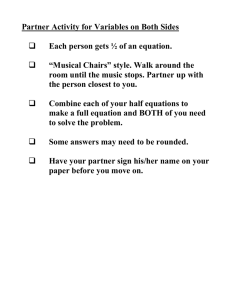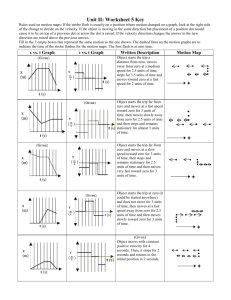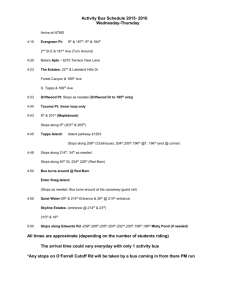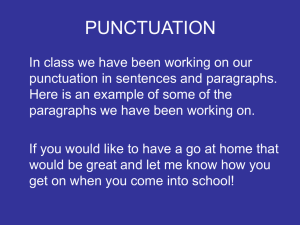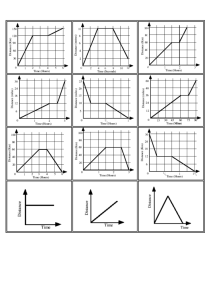Floyd v. City of New York
advertisement
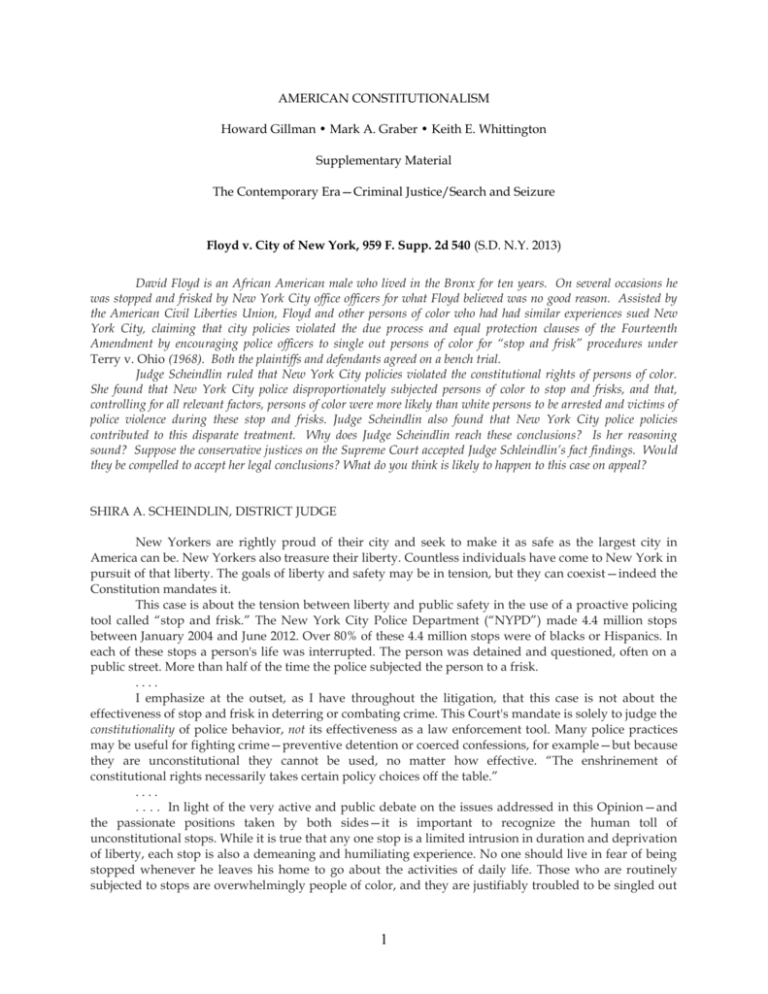
AMERICAN CONSTITUTIONALISM Howard Gillman • Mark A. Graber • Keith E. Whittington Supplementary Material The Contemporary Era—Criminal Justice/Search and Seizure Floyd v. City of New York, 959 F. Supp. 2d 540 (S.D. N.Y. 2013) David Floyd is an African American male who lived in the Bronx for ten years. On several occasions he was stopped and frisked by New York City office officers for what Floyd believed was no good reason. Assisted by the American Civil Liberties Union, Floyd and other persons of color who had had similar experiences sued New York City, claiming that city policies violated the due process and equal protection clauses of the Fourteenth Amendment by encouraging police officers to single out persons of color for “stop and frisk” procedures under Terry v. Ohio (1968). Both the plaintiffs and defendants agreed on a bench trial. Judge Scheindlin ruled that New York City policies violated the constitutional rights of persons of color. She found that New York City police disproportionately subjected persons of color to stop and frisks, and that, controlling for all relevant factors, persons of color were more likely than white persons to be arrested and victims of police violence during these stop and frisks. Judge Scheindlin also found that New York City police policies contributed to this disparate treatment. Why does Judge Scheindlin reach these conclusions? Is her reasoning sound? Suppose the conservative justices on the Supreme Court accepted Judge Schleindlin’s fact findings. Would they be compelled to accept her legal conclusions? What do you think is likely to happen to this case on appeal? SHIRA A. SCHEINDLIN, DISTRICT JUDGE New Yorkers are rightly proud of their city and seek to make it as safe as the largest city in America can be. New Yorkers also treasure their liberty. Countless individuals have come to New York in pursuit of that liberty. The goals of liberty and safety may be in tension, but they can coexist—indeed the Constitution mandates it. This case is about the tension between liberty and public safety in the use of a proactive policing tool called “stop and frisk.” The New York City Police Department (“NYPD”) made 4.4 million stops between January 2004 and June 2012. Over 80% of these 4.4 million stops were of blacks or Hispanics. In each of these stops a person's life was interrupted. The person was detained and questioned, often on a public street. More than half of the time the police subjected the person to a frisk. .... I emphasize at the outset, as I have throughout the litigation, that this case is not about the effectiveness of stop and frisk in deterring or combating crime. This Court's mandate is solely to judge the constitutionality of police behavior, not its effectiveness as a law enforcement tool. Many police practices may be useful for fighting crime—preventive detention or coerced confessions, for example—but because they are unconstitutional they cannot be used, no matter how effective. “The enshrinement of constitutional rights necessarily takes certain policy choices off the table.” .... . . . . In light of the very active and public debate on the issues addressed in this Opinion—and the passionate positions taken by both sides—it is important to recognize the human toll of unconstitutional stops. While it is true that any one stop is a limited intrusion in duration and deprivation of liberty, each stop is also a demeaning and humiliating experience. No one should live in fear of being stopped whenever he leaves his home to go about the activities of daily life. Those who are routinely subjected to stops are overwhelmingly people of color, and they are justifiably troubled to be singled out 1 when many of them have done nothing to attract the unwanted attention. Some plaintiffs testified that stops make them feel unwelcome in some parts of the City, and distrustful of the police. This alienation cannot be good for the police, the community, or its leaders. Fostering trust and confidence between the police and the community would be an improvement for everyone. .... Plaintiffs assert that the City, and its agent the NYPD, violated both the Fourth Amendment and the Equal Protection Clause of the Fourteenth Amendment of the United States Constitution. In order to hold a municipality liable for the violation of a constitutional right, plaintiffs “must prove that ‘action pursuant to official municipal policy’ caused the alleged constitutional injury.” “Official municipal policy includes the decisions of a government’s lawmakers, the acts of its policymaking officials, and practices so persistent and widespread as to practically have the force of law.” The Fourth Amendment protects all individuals against unreasonable searches or seizures. The Supreme Court has held that the Fourth Amendment permits the police to “stop and briefly detain a person for investigative purposes if the officer has a reasonable suspicion supported by articulable facts that criminal activity ‘may be afoot,’ even if the officer lacks probable cause.” “Reasonable suspicion is an objective standard; hence, the subjective intentions or motives of the officer making the stop are irrelevant.” The test for whether a stop has taken place in the context of a police encounter is whether a reasonable person would have felt free to terminate the encounter. “‘[T]o proceed from a stop to a frisk, the police officer must reasonably suspect that the person stopped is armed and dangerous.’” The Equal Protection Clause of the Fourteenth Amendment guarantees to every person the equal protection of the laws. It prohibits intentional discrimination based on race. Intentional discrimination can be proved in several ways, two of which are relevant here. A plaintiff can show: (1) that a facially neutral law or policy has been applied in an intentionally discriminatory manner; or (2) that a law or policy expressly classifies persons on the basis of race, and that the classification does not survive strict scrutiny. Because there is rarely direct proof of discriminatory intent, circumstantial evidence of such intent is permitted. “The impact of the official action—whether it bears more heavily on one race than another—may provide an important starting point.” The following facts . . . are uncontested: • Between January 2004 and June 2012, the NYPD conducted over 4.4 million Terry stops. • The number of stops per year rose sharply from 314,000 in 2004 to a high of 686,000 in 2011. • 52% of all stops were followed by a protective frisk for weapons. A weapon was found after 1.5% of these frisks. In other words, in 98.5% of the 2.3 million frisks, no weapon was found. • 8% of all stops led to a search into the stopped person's clothing, ostensibly based on the officer feeling an object during the frisk that he suspected to be a weapon, or immediately perceived to be contraband other than a weapon. In 9% of these searches, the felt object was in fact a weapon. 91% of the time, it was not. In 14% of these searches, the felt object was in fact contraband. 86% of the time it was not. • 6% of all stops resulted in an arrest, and 6% resulted in a summons. The remaining 88% of the 4.4 million stops resulted in no further law enforcement action. • In 52% of the 4.4 million stops, the person stopped was black, in 31% the person was Hispanic, and in 10% the person was white. • In 2010, New York City’s resident population was roughly 23% black, 29% Hispanic, and 33% white. • In 23% of the stops of blacks, and 24% of the stops of Hispanics, the officer recorded using force. The number for whites was 17%. • Weapons were seized in 1.0% of the stops of blacks, 1.1% of the stops of Hispanics, and 1.4% of the stops of whites. • Contraband other than weapons was seized in 1.8% of the stops of blacks, 1.7% of the stops of Hispanics, and 2.3% of the stops of whites. • Between 2004 and 2009, the percentage of stops where the officer failed to state a specific suspected crime rose from 1% to 36%. .... 2 . . . . [T]he analysis of the UF–250 database reveals that at least 200,000 stops were made without reasonable suspicion. The actual number of stops lacking reasonable suspicion was likely far higher. . . . . With respect to plaintiffs’ Fourteenth Amendment claim, I reject the testimony of the City’s experts that the race of crime suspects is the appropriate benchmark for measuring racial bias in stops. The City and its highest officials believe that blacks and Hispanics should be stopped at the same rate as their proportion of the local criminal suspect population. But this reasoning is flawed because the stopped population is overwhelmingly innocent—not criminal. There is no basis for assuming that an innocent population shares the same characteristics as the criminal suspect population in the same area. Instead, I conclude that the benchmark used by plaintiffs' expert—a combination of local population demographics and local crime rates (to account for police deployment) is the most sensible. Based on the expert testimony I find the following: (1) The NYPD carries out more stops where there are more black and Hispanic residents, even when other relevant variables are held constant. The racial composition of a precinct or census tract predicts the stop rate above and beyond the crime rate. (2) Blacks and Hispanics are more likely than whites to be stopped within precincts and census tracts, even after controlling for other relevant variables. This is so even in areas with low crime rates, racially heterogeneous populations, or predominately white populations. (3) For the period 2004 through 2009, when any law enforcement action was taken following a stop, blacks were 30% more likely to be arrested (as opposed to receiving a summons) than whites, for the same suspected crime. (4) For the period 2004 through 2009, after controlling for suspected crime and precinct characteristics, blacks who were stopped were about 14% more likely—and Hispanics 9% more likely—than whites to be subjected to the use of force. (5) For the period 2004 through 2009, all else being equal, the odds of a stop resulting in any further enforcement action were 8% lower if the person stopped was black than if the person stopped was white. In addition, the greater the black population in a precinct, the less likely that a stop would result in a sanction. Together, these results show that blacks are likely targeted for stops based on a lesser degree of objectively founded suspicion than whites. With respect to both the Fourth and Fourteenth Amendment claims, one way to prove that the City has a custom of conducting unconstitutional stops and frisks is to show that it acted with deliberate indifference to constitutional deprivations caused by its employees—here, the NYPD. The evidence at trial revealed significant evidence that the NYPD acted with deliberate indifference. As early as 1999, a report from New York’s Attorney General placed the City on notice that stops and frisks were being conducted in a racially skewed manner. Nothing was done in response. In the years following this report, pressure was placed on supervisors to increase the number of stops. Evidence at trial revealed that officers have been pressured to make a certain number of stops and risk negative consequences if they fail to achieve the goal. Without a system to ensure that stops are justified, such pressure is a predictable formula for producing unconstitutional stops. . . . In addition, the evidence at trial revealed that the NYPD has an unwritten policy of targeting “the right people” for stops. In practice, the policy encourages the targeting of young black and Hispanic men based on their prevalence in local crime complaints. This is a form of racial profiling. While a person’s race may be important if it fits the description of a particular crime suspect, it is impermissible to subject all members of a racially defined group to heightened police enforcement because some members of that group are criminals. The Equal Protection Clause does not permit race-based suspicion. Much evidence was introduced regarding inadequate monitoring and supervision of unconstitutional stops. Supervisors routinely review the productivity of officers, but do not review the facts of a stop to determine whether it was legally warranted. Nor do supervisors ensure that an officer has made a proper record of a stop so that it can be reviewed for constitutionality. Deficiencies were also shown in the training of officers with respect to stop and frisk and in the disciplining of officers when they were found to have made a bad stop or frisk. Despite the mounting evidence that many bad stops were made, that officers failed to make adequate records of stops, and that discipline was spotty or nonexistent, little has been done to improve the situation. One example of poor training is particularly telling. Two officers testified to their understanding of the term “furtive movements.” One explained that “furtive movement is a very broad concept,” and could include a person “changing direction,” “walking in a certain way,” “[a]cting a little suspicious,” 3 “making a movement that is not regular,” being “very fidgety,” “going in and out of his pocket,” “going in and out of a location,” “looking back and forth constantly,” “looking over their shoulder,” “adjusting their hip or their belt,” “moving in and out of a car too quickly,” “[t]urning a part of their body away from you,” “[g]rabbing at a certain pocket or something at their waist,” “getting a little nervous, maybe shaking,” and “stutter[ing].” Another officer explained that “usually” a furtive movement is someone “hanging out in front of [a] building, sitting on the benches or something like that” and then making a “quick movement,” such as “bending down and quickly standing back up,” “going inside the lobby ... and then quickly coming back out,” or “all of a sudden becom[ing] very nervous, very aware.” If officers believe that the behavior described above constitutes furtive movement that justifies a stop, then it is no surprise that stops so rarely produce evidence of criminal activity. .... In conclusion, I find that the City is liable for violating plaintiffs’ Fourth and Fourteenth Amendment rights. The City acted with deliberate indifference toward the NYPD’s practice of making unconstitutional stops and conducting unconstitutional frisks. Even if the City had not been deliberately indifferent, the NYPD's unconstitutional practices were sufficiently widespread as to have the force of law. In addition, the City adopted a policy of indirect racial profiling by targeting racially defined groups for stops based on local crime suspect data. This has resulted in the disproportionate and discriminatory stopping of blacks and Hispanics in violation of the Equal Protection Clause. Both statistical and anecdotal evidence showed that minorities are indeed treated differently than whites. For example, once a stop is made, blacks and Hispanics are more likely to be subjected to the use of force than whites, despite the fact that whites are more likely to be found with weapons or contraband. I also conclude that the City’s highest officials have turned a blind eye to the evidence that officers are conducting stops in a racially discriminatory manner. In their zeal to defend a policy that they believe to be effective, they have willfully ignored overwhelming proof that the policy of targeting “the right people” is racially discriminatory and therefore violates the United States Constitution. One NYPD official has even suggested that it is permissible to stop racially defined groups just to instill fear in them that they are subject to being stopped at any time for any reason—in the hope that this fear will deter them from carrying guns in the streets. The goal of deterring crime is laudable, but this method of doing so is unconstitutional. I recognize that the police will deploy their limited resources to high crime areas. This benefits the communities where the need for policing is greatest. But the police are not permitted to target people for stops based on their race. Some may worry about the implications of this decision. They may wonder: if the police believe that a particular group of people is disproportionately responsible for crime in one area, why should the police not target that group with increased stops? Why should it matter if the group is defined in part by race? Indeed, there are contexts in which the Constitution permits considerations of race in law enforcement operations. What is clear, however, is that the Equal Protection Clause prohibits the practices described in this case. A police department may not target a racially defined group for stops in general—that is, for stops based on suspicions of general criminal wrongdoing—simply because members of that group appear frequently in the police department's suspect data. The Equal Protection Clause does not permit the police to target a racially defined group as a whole because of the misdeeds of some of its members. To address the violations that I have found, I shall order various remedies including, but not limited to, an immediate change to certain policies and activities of the NYPD, a trial program requiring the use of body-worn cameras in one precinct per borough, a community-based joint remedial process to be conducted by a court-appointed facilitator, and the appointment of an independent monitor to ensure that the NYPD’s conduct of stops and frisks is carried out in accordance with the Constitution and the principles enunciated in this Opinion, and to monitor the NYPD’s compliance with the ordered remedies. .... 4
